Who is the blogger?
Archived entry
Ocean's 11 (1960, 2001) and Around the World in 80 Days (1956)
Phileas Fogg, Jules Verne and the Rat Pack: Odd Bedfellows
Frank Sinatra’s Rat Pack pulls one over on Vegas with style and flare in Ocean’s11 and David Niven is Phileas Fogg while his co-star, Cantinflas, is not Passepartout in Around the World in 80 Days.
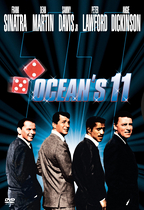 It was an act of God – a thunderstorm, one of several that came through the area. On Saturday Night while I was watching my movies on SNAM, the power went out. I had gone to bed before the end of the second feature, Ocean’s 11, trusting that my VCR would pick up the end of the movie for me to watch the next day.
It was an act of God – a thunderstorm, one of several that came through the area. On Saturday Night while I was watching my movies on SNAM, the power went out. I had gone to bed before the end of the second feature, Ocean’s 11, trusting that my VCR would pick up the end of the movie for me to watch the next day.
It was not to be so. The next morning I discovered that the VCR had not captured the end of the movie and that I would probably never see the grand finale of the heist. Rats! We were leaving for the annual cottage holiday, so it did not seem reasonable for me to trot down to the classic video rental store downtown to see if I could find Frank Sinatra and his pals “doing Vegas” in their own inimitable style.
So was born the idea that maybe I should see the updated version of Ocean’s 11 with George Clooney and Brad Pitt. I watched Clooney and company do their thing with the Vegas casinos and enjoyed the ride. My husband was actually interested in watching the rental of this one with me. Finally, a film we could agree to watch together - a truly fortuitous event!
It was not the same movie . That was the conclusion I reached after I invested the two admittedly entertaining hours in viewing the new guys pull off their version of the ultimate sting operation in Las Vegas . There were certainly comparisons that could be made between the original and the update of Ocean’s 11, but the plots, the players and the underlying purpose of the action are all very different in the two versions.
 The original version with Frank Sinatra does capture the look and feel of a bygone era in “old” Las Vegas . You get the picture of what was considered the ultimate in suave in that day with Sammy Davis Jr. and Dean Martin making a smooth delivery on their musical numbers. It looks like one big lark for the old army buddies (well they are former WWII paratroopers) with all of the friendly camaraderie that goes along with it. The spirit of easy camaraderie that is portrayed on the screen is more than likely linked to the fraternity felt in real life between some of the actors. Frank Sinatra’s real life buddies, a.k.a. the Rat Pack, made a number of movies together. They didn’t even have to leave their gigs in Vegas to do this one. One of the things that the old and the new versions of Ocean’s 11 had in common was that it looked like the actors were having fun. It probably was the case that both movies were actually fun to make.
The original version with Frank Sinatra does capture the look and feel of a bygone era in “old” Las Vegas . You get the picture of what was considered the ultimate in suave in that day with Sammy Davis Jr. and Dean Martin making a smooth delivery on their musical numbers. It looks like one big lark for the old army buddies (well they are former WWII paratroopers) with all of the friendly camaraderie that goes along with it. The spirit of easy camaraderie that is portrayed on the screen is more than likely linked to the fraternity felt in real life between some of the actors. Frank Sinatra’s real life buddies, a.k.a. the Rat Pack, made a number of movies together. They didn’t even have to leave their gigs in Vegas to do this one. One of the things that the old and the new versions of Ocean’s 11 had in common was that it looked like the actors were having fun. It probably was the case that both movies were actually fun to make.
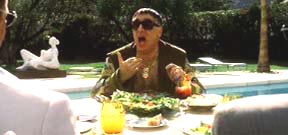 Another thing that both versions had in common were the clothes: not that they wore the same clothes, mind you. The costumes had the effect of making a statement about the era. Chic in 1960 with all of those skinny ties and billowing satin evening dresses looked quite different than chic in 2001. They say that clothes make the man. I found that to be the case in the 2001 version with George Clooney as alpha male Danny Ocean, Brad Pitt in the role of Rusty Ryan, the number one, Andy Garcia as the take-off on the menacing eastern despot, Terry Benedict, and Elliott Gould as the over the top and totally outrageous Reuben Tishkoff. In each case, clothing contributed significantly to character development. Costume designer Jeffrey Kurland went on for quite a while in the supporting interviews on the CD-ROM of the 2001 version about how he obtained the all- important effect of making Brad Pitt “shine” in his ultra sophisticated look as the super suave conman and card shark..
Another thing that both versions had in common were the clothes: not that they wore the same clothes, mind you. The costumes had the effect of making a statement about the era. Chic in 1960 with all of those skinny ties and billowing satin evening dresses looked quite different than chic in 2001. They say that clothes make the man. I found that to be the case in the 2001 version with George Clooney as alpha male Danny Ocean, Brad Pitt in the role of Rusty Ryan, the number one, Andy Garcia as the take-off on the menacing eastern despot, Terry Benedict, and Elliott Gould as the over the top and totally outrageous Reuben Tishkoff. In each case, clothing contributed significantly to character development. Costume designer Jeffrey Kurland went on for quite a while in the supporting interviews on the CD-ROM of the 2001 version about how he obtained the all- important effect of making Brad Pitt “shine” in his ultra sophisticated look as the super suave conman and card shark..
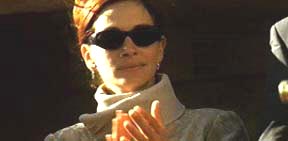 I am afraid that things did not work out so well for poor Julia. As the only lady in the ensemble and the focus of much attention, something dreadful seems to have happened on the way from the dressing room to the movie set. Whether it was the make-up, the costume design, the way the camera shot her or just the way she was feeling that day, Julia Roberts just doesn’t look all that great in this movie. But then, I thought that Angie Dickinson playing Danny Ocean ’s long-suffering wife, Beatrice, did not come off all that well either in the original. In that case I think that the difficulties with the portrayal of Beatrice had less to do with the mechanics of how the scenes were shot and more to do with how the part was written.
I am afraid that things did not work out so well for poor Julia. As the only lady in the ensemble and the focus of much attention, something dreadful seems to have happened on the way from the dressing room to the movie set. Whether it was the make-up, the costume design, the way the camera shot her or just the way she was feeling that day, Julia Roberts just doesn’t look all that great in this movie. But then, I thought that Angie Dickinson playing Danny Ocean ’s long-suffering wife, Beatrice, did not come off all that well either in the original. In that case I think that the difficulties with the portrayal of Beatrice had less to do with the mechanics of how the scenes were shot and more to do with how the part was written.
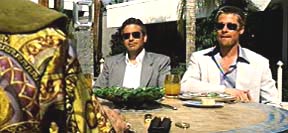 Critics and moviegoers alike seem to say that both of these versions of Ocean’s 11 capture the “epitome of cool”. It’s just that what is “ultra cool” looks different 40 years apart. Gambling and sex remain stable, the sophistication of security systems goes up while the rate of smoking plummets and the dress code varies according to the fickle winds of fashion. The “super cool” of yesteryear looks somewhat quaint and slightly laughable as will today’s epitome of sophistication by the time we get to tomorrow.
Critics and moviegoers alike seem to say that both of these versions of Ocean’s 11 capture the “epitome of cool”. It’s just that what is “ultra cool” looks different 40 years apart. Gambling and sex remain stable, the sophistication of security systems goes up while the rate of smoking plummets and the dress code varies according to the fickle winds of fashion. The “super cool” of yesteryear looks somewhat quaint and slightly laughable as will today’s epitome of sophistication by the time we get to tomorrow.
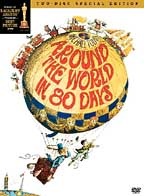 Phileas Fogg from Jules Verne’s original novel, Around the World in 80 Days, was certainly a man ahead of his time. The very popular novel’s reputation probably rested very much on the colourful explorations of exotic destinations that appealed to the modern-minded people of that era. The 1956 movie of the same name seems to rest its reputation on the same kind of appeal to middle-America plus the attraction of multiple cameo appearances of famous actors as rounded up by the producer, Michael Todd. According to the Interviews, convincing big name actors to appear as cameos in the film seems to have been one of Mr. Todd’s chief talents.
Phileas Fogg from Jules Verne’s original novel, Around the World in 80 Days, was certainly a man ahead of his time. The very popular novel’s reputation probably rested very much on the colourful explorations of exotic destinations that appealed to the modern-minded people of that era. The 1956 movie of the same name seems to rest its reputation on the same kind of appeal to middle-America plus the attraction of multiple cameo appearances of famous actors as rounded up by the producer, Michael Todd. According to the Interviews, convincing big name actors to appear as cameos in the film seems to have been one of Mr. Todd’s chief talents.
The cast list is ridiculously long. It includes all manner of persons from Sir John Gielgud to John Mills, from Marlene Dietrich to Shirley MacLaine, and Buster Keaton to Red Skelton. David Niven is entirely memorable as the quintessential modern man, Phileas Fogg, time piece collector and whist player extraordinaire. Niven is definitely a star due to the amount of time he occupies the prime place onscreen, but in this film he definitely shares the firmament with a starry host.
 During the Interviews, director Michael Anderson tells a funny little story about Charles Boyer, who evidently had only one acceptable side of his face to shoot to good advantage. Anderson tells the story presumably to illustrate how difficult it was on the set to manage such large amounts of talent often with such large egos in tow.
During the Interviews, director Michael Anderson tells a funny little story about Charles Boyer, who evidently had only one acceptable side of his face to shoot to good advantage. Anderson tells the story presumably to illustrate how difficult it was on the set to manage such large amounts of talent often with such large egos in tow.
 The casting directors must certainly have been busy with all of those actors milling about. The one thing that I can’t understand with regard to casting choices is that Passepartout, Fogg’s valet, is played by a Mexican actor named Cantinflas. Apparently the actor was very famous at the time. Cantinflas used no stunt doubles and did his own bullfighting scenes in the movie, amongst other remarkable things. He also gave a lot of money to the poor in Mexico City , thus making himself a national hero in Mexico during his own lifetime. However, the Mexican actor had such a thick Spanish accent (no, it’s not a French accent) that one can scarcely understand the English. It was a distraction for me.
The casting directors must certainly have been busy with all of those actors milling about. The one thing that I can’t understand with regard to casting choices is that Passepartout, Fogg’s valet, is played by a Mexican actor named Cantinflas. Apparently the actor was very famous at the time. Cantinflas used no stunt doubles and did his own bullfighting scenes in the movie, amongst other remarkable things. He also gave a lot of money to the poor in Mexico City , thus making himself a national hero in Mexico during his own lifetime. However, the Mexican actor had such a thick Spanish accent (no, it’s not a French accent) that one can scarcely understand the English. It was a distraction for me.
The effort of producing this film was monumental at the time. I would not say that the movie is remembered for being a particularly good film. It is more like watching a stream of constantly changing shapes and colours in a laser light show. It is interesting to watch for a while for the entertainment value, but it quickly fades from memory after the experience is over.
 I found the combination of these two movies on SNAM to be rather odd. The only connection that I could make out between the two features on Saturday Night at the Movies was Frank Sinatra. Sinatra had a very brief cameo in Around the World in 80 Days as the piano man in a wild west bar at one point. Apparently, Sinatra’s agreement to appear in the film opened the doors for other Hollywood stars to agree to make cameos for Todd. I suppose this shows the influence that Sinatra had at that time in Hollywood .
I found the combination of these two movies on SNAM to be rather odd. The only connection that I could make out between the two features on Saturday Night at the Movies was Frank Sinatra. Sinatra had a very brief cameo in Around the World in 80 Days as the piano man in a wild west bar at one point. Apparently, Sinatra’s agreement to appear in the film opened the doors for other Hollywood stars to agree to make cameos for Todd. I suppose this shows the influence that Sinatra had at that time in Hollywood .
While none of these films can be billed as the greatest movies ever made, I don’t really regret watching them. I only regret that I never got to see the end of the 1960 version of Ocean’s 11 with the coffin scene. The d énouement of the 2001 version with Debussy ’s “Clair de Lune” from “La Suite Bergamasque”was truly strange but satisfying during the fountain scene after the big heist. It gave those guys some real class. And class was what it was all about!
Related Reading:
- A modern day Phileas Fogg, Michael Palin (travelogues shown on TVO) recreates the journey Around the World in 80 Days
- What I learned on my cinematic voyage around the world in 80 days – The English word “thug” comes from the Sanskrit word “thugee” – devotees of the goddess Kali who strangled their human victims as a part of cultic devotions. Ughhh!
- Finding camaraderie in the real world
- I just found the perfect . . . Gotta get the right look? Spending all your money on clothes?
- Let's take it from the top. Who is directing your life?
Posted on Wednesday, July 26, 2006 at 03:25PM by ![]() Catherine Savard |
Catherine Savard | ![]() Post a Comment
Post a Comment




